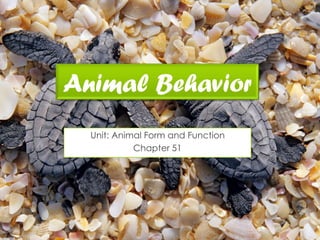
Animal Behavior Concept Review
- 1. Animal Behavior Unit: Animal Form and Function Chapter 51
- 2. Lecture Outline Concepts: 51.1 Stimuli causing simple and complex behaviors 51.2 Experience and Behavior 51.3 Selection for Individual survival and Reproductive success 51.4 Fitness beyond individual survival
- 3. 51.1 Stimuli and Mediation What stimulus elicits the behavior, and what physiological mechanisms mediate the response? Proximate causation: “How” -environmental stimulus that triggers the behavior
- 4. Fixed Action Patterns Fixed Action Pattern: sequence of unlearned acts linked to a simple stimulus -Unchangeable and carried out to completion Sign Stimulus: trigger for the behavior (ie: red object prompting the male stickleback’s aggressive behavior) Habituation: ignoring stimulus after constant repetition
- 5. Migration stimulated by environmental cues; magnetic pull Circadian clock synchronized with light & dark
- 6. Animal Signals and Communication Pheromones: chemical signals emitted by members of one species to affect other members of same species Visual signals: physical signals to warn or send a message to members of same species (ie: white warning of mockingbird) Auditory signals: sound messages (ie: screech of blue jay)
- 7. Choice Chamber Experiment In an investigation of fruit-fly behavior, a covered choice chamber is used to test whether the spatial distribution of flies is affected by the presence of a substance placed at one end of the chamber. To test the flies’ preference for glucose, 60 flies are introduced into the middle of the choice chamber at the insertion point indicated by the arrow in the figure above. A cotton ball soaked with a 10% glucose solution is placed at one end of the chamber, and a dry cotton ball with no solution is placed at the other end. The positions of flies are observed and recorded every minute for 10 minutes.
- 9. Chi-Square A Chi-square (Χ2) Goodness of Fit calculation compares the experimental data with a theoretical expected distribution Chi-Square = Σ O−E 2 E Trial 1 E O (O-E) (O-E)2 (O-E)2/E 1 6.0 14 8.0 64 11 2 6.0 2.0 -4.0 16 2.7 3 6.0 2.0 -4.0 16 2.7 4 6.0 4 -2.0 4 .67 Ʃ 24 22 -2.0 100 17.1
- 10. 0 5 10 15 20 25 30 Trial 1 Trial 2 Trial 3 Trial 4 Trial 5 Trial 6 Cricket Courtship Behavior to Antennae Chi Square Values Degrees of Freedom: A measure of how many values can vary in a statistical calculation. n-1 where n=independent variables
- 11. 51.2 Experience and Behavior How does the animal’s experience during growth and development influence the response? Proximate causation: “How” The learning process that influences the animal
- 12. Learning Imprinting: learned and innate components, limited to a sensitive period and are generally irreversible Spatial & Cognitive Maps: using memory to reflect the environment through representation in the nervous system
- 13. Cognition: decision-making through reasoning, recollection, and judgment Social: Learning through observation of others
- 14. Associative: ability to associate one feature of environment with another -Classical conditioning: arbitrary stimulus becomes associated with a particular outcome -Operant conditioning: trial-and-error learning, reward and punishment
- 15. 51.3 Individual & Reproduction How does the behavior aid survival and reproduction? Ultimate causation: “Why” How these behaviors increase the survival and reproductive success
- 16. Foraging Behavior Foraging behavior is based on the efficiency of the method. Evolution of foraging is shown in the optimal foraging model; natural selection favors minimal cost, maximum benefits
- 17. Mating Behavior Monogamous: one male and one female Promiscuous: no mating bond Polygamous: an individual of one sex with several of the other -Polygynous: one male and lots of females -Polyandrous: one female and lots of males
- 18. Intersexual Selection: sexual selection; one sex chooses mates based on certain traits -sexual selection influenced by imprinting; chooses father’s traits -Mate-choice copying: females copy other females’ choices Intrasexual Selection: competition within the gender
- 19. 51.4 Evolution of Behavior What is the behavior’s evolutionary history? Ultimate causation: “Why” Inclusive fitness benefits the population as a whole
- 20. Good of the Whole Altruism: selfless behavior that decreases the individual’s fitness but increases the fitness of others in the population Inclusive Fitness: by helping other members of the same species and reproducing, the genes of the individual proliferate